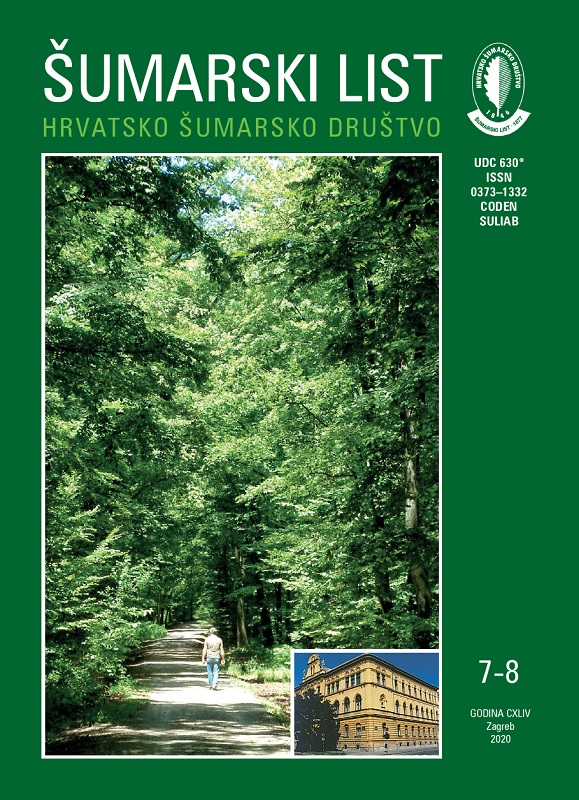
broj: 7-8/2020
pdf (6,01 MB) |
|
||||||||||||||
| RIJEČ UREDNIŠTVA | ||
| Uredništvo | ||
| Parafiscal levies – definition and who should pay them pdf HR EN | 337 | |
| IZVORNI ZNANSTVENI ČLANCI | ||
| Milan Pernek, Marta Kovač, Nikola Lacković | UDK 630* 453 (001) https://doi.org/10.31298/sl.144.7-8.1 | |
| Testing of biological effectiveness of pheromones and traps for catch of mediterranean bark beetle Orthotomicus erosus (Coleoptera, Curculionidae) pdf HR EN | 339 | |
| Mladen Ognjenović, Tom Levanič, Nenad Potočić, Damir Ugarković, Krunoslav Indir, Ivan Seletković | UDK 630* 425 + 111 (001) https://doi.org/10.31298/sl.144.7-8.2 | |
| Interrelations of various tree vitality indicators and their reaction to climatic conditions on a european beech (Fagus sylvatica L.) plot pdf HR EN | 351 | |
| Simon Lendvai, Jurij Diaci, Dušan Roženbergar | UDK 630* 242 (001) https://doi.org/10.31298/sl.144.7-8.3 | |
| Response of black alder (Alnus glutinosa (L.) Gaertn.) to selective thinning of various intensities: a half-century study in northeastern Slovenia pdf HR EN | 367 | |
| Summary Pure black alder stands are specific and require adapted silvicultural models. To determine the best intensity of selective thinning in such stands, research plots were established in Polanski Log in 1967. Three thinning intensities were selected: control, moderate and high. These stands are presently in a mature phase. In 1967, 1973, 1979, 1983, 1993, 1998 and 2018 diameter at breast height was measured and social status, vitality, tendency, silvicultural role, crown length and overall quality were estimated. The differences in black alder responses to thinning intensities were analysed and the results were compared with recommendations for selective high thinning and newer crop tree situational thinning models. Diameter increments were lower than expected regardless of thinning intensity. In moderately thinned plots and control plots diameter increment was the same (0.33 cm/year); high intensity thinning plots showed higher increment (0.37 cm/year). Dominant trees had slightly higher increment regardless of thinning model. Compared to thinning models with a lower number of crop trees, density and basal area of studied stands were significantly higher and diameter increments lower. We attribute the small diameter increments and small differences among thinning models to insufficient intensity and partially to inconsistent thinning. The results indicate that thinning must be of higher intensity and the largest-diameter trees which display the best vigour, quality, tendency, and which have well formed, long crowns, must be promoted from the beginning. Key words: black alder (Alnus glutinosa (L.) Gaertn.); thinning; diameter increment; traditional selection model; situational thinning model | ||
| Besim Balić, Ante Seletković, Ahmet Lojo, Aida Ibrahimspahić, Jusuf Musić, Admir Avdagić, Velid Halilović | UDK 630* 516 (001) https://doi.org/10.31298/sl.144.7-8.4 | |
| Model for estimation merchantable wood volume of spruce (Picea abies Karst) in Canton 10, Federation of Bosnia and Herzegovina pdf HR EN | 379 | |
| Hüseyin Ogfuz Çoban, Halis Bereket | UDK 630* 432 (001 https://doi.org/10.31298/sl.144.7-8.5 | |
| Visibility analysis of fire lookout towers protecting the Mediterranean forest ecosystems in Turkey pdf HR EN | 393 | |
| PREGLEDNI ČLANCI | ||
| Željko Španjol, Boris Dorbić, Nikola Vrh, Ivana Gašparović, Ivan Tolić, Milan Vojinović | UDK 630* 187 + 174 https://doi.org/10.31298/sl.144.7-8.6 | |
| Vegetative and dendrological characteristics of Hober forest park in Korčula pdf HR EN | 409 | |


